
After a semester abroad in the cool quiet blue of Helsinki and an exhilarating journey across Eastern Europe, I begin my summer semester with WUSTL's Sam Fox School in the colorful loud vibrant Barcelona as Alexander embarks on his cycling pilgrimage to the Camino de Santiago with his father.
The entry is punctuated with excerpts from my Barcelona summer seminar project entitled: A Quixotic City. It is an A5 sized book (a.k.a. misalito) describing my experience of Barcelona.
"Sandwiched somewhere between the sky and the earth you find Barcelona. A sensuous city nestled in a dimple of the Serra de Collserola ridge, between the mouths of the Llobregat and Besòs rivers, and perched on the coast of the Balearic Sea. I inhabit a point in this plane dubbed District 1, Obradores 9°. From this point, lines radiate outwards tracing a personal journey throughout the city of Barcelona."
- excerpt from A Quixotic City

View of El Gotic and Barcelonetta from Montjuïc
Being so replete with points of interest and so rich with history, I broke my time abroad in Barcelona into 3 entries. I begin by introducing the sensuous city of Barcelona, and will continue with the architecture of the old and the new in Barcelona. The conclusion of the curriculum ends in Portugal.
Barcelona
Renown for their ferocity in Catalonian pride, Barcelona is the capital of the Catalonia region of Spain. It is located on the Iberian Peninsula along the Mediterranean sea. It was founded as a Roman city with evidence of ancient ruins still exposed in some areas of the modern city.
My temporary domicile is located in the beating heart of the old Barcelona, El Barri Gòtic. El Gòtic lays between two streets, La Rambla to the west and Via Laietana to the east. Cities often reflect characteristics of the natural landscape on which they were built. Before the 18th century, La Rambla was a path running besides a stream and the city walls. By the 15th century, Barcelona had already expanded beyond the walls by 1854 the city walls had been torn down and replaced by a central pedestrian promenade.

"The city is alive. It changes, it ages, it beats with a system of supports. Beneath the skin of the city runs the arteries veins and internal organs that allows for life on the surface. The nerves of the city manifest as the network of information cables that carry signals and send messages throughout; the lifeblood of the city weaves its way through the water pipes; the excrement of the city carries itself in the sewer system.
The streets of the subterranean Barcelona are filled with sheets of silt, slate and limestone instead of air. The living roots of trees do not venture this far below. The place is deserted except for the occasional network of pipes and cables. Every so often, in the center of the city, a large hollow tube station cuts through the earth. Life from above seeps below in a transient state. It is quiet then loud, busy then empty. A flux of states."
- excerpt from A Quixotic City
Barcelona Cathedral (La Seu)
Located in the Gothic quarter, at San Jaume Square. Constructed during the 13th to 15th century, the cathedral is dedicated to Santa Eulalia of Barcelona. Eulalia was a young virgin who suffered martyrdom during the Roman rule. Her body is entombed in the cathedral’s crypt.
Neo-Gothic façade of the Barcelona Cathedral with large bell towers covered in Gothic pinnacles.
High vaulted ceiling with incredible brickwork and an interior of the dome faced with wood coffering.
Intricately sculpted choir.
Well of the Geese (Font de les Oques)
With an entrance on a smaller side street, the cathedral has a secluded Gothic cloister with 13 white geese that are purported to represent the age of Saint Eulalia when she was martyred.
Mercat de Sant Josep de la Boqueria: La Boqueria
The entrance of La Boqueria is nestled between buildings along La Rambla in the heart of the old Barcelona. A colorful ornate metal arch frames the main entrance of the market. The original market, designed by Mas Vila in 1853, once consisted of open sheds.
Mercat de Santa Caterina
Mercat de Santa Caterina is a remodeled 19th century market located on La Riberta, just east of Via Laietana. The market was the first covered market in the city when it was built in 1848. It was redesigned by Enric Miralles and Benedetta Tagliabue in 1997. At the time of the restoration, the market was architecturally unstable and commercially dying.

Palau de la Música
The Palau de la Música is a concert hall in Barcelona located a block east of Via Laietana. It was designed by the architect Lluís Domènech i Montaner, and completed in 1908. In 1997 it was declared a UNESCO World Heritage Site.

Approaching the Palau de la Música from Via Laietana.

The facade of the Palau de la Música.

Detail of the facade of the Palau de la Música.
Barcelona by Bike
As a part of our initiation into Barcelona our class took a bike ride along the Mediterranean coast. The route began at the Plaça Sant Jaume and ended at the Diagonal Mar.
The bike route. Including stops to sketch it took roughly 6 hours.
Barcelonetta
The bike gang at the beginning of the tour.
The W Hotel in Barceloneta.
Frank Gehry’s Peix (Catalan for “fish”)
The sculpture sits at the base of the Hotel Arts, one of the tallest buildings in Barcelona. Gehry was commissioned to build the sculpture for the 1992 Summer Olympics. The sculpture is made of stone, steel, and glass.
Parc de Recerca Biomédica

Avinguda d'Icària
The Avinguda Diagonal was originally proposed by the engineer and urban planner Ildefons Cerdà to be the cities largest avenue. The steel and wooden canopy runs along a dividing median and has seating areas.
Parc Diagonal Mar by Enric Miralles
The Parc Diagonal Mar was inaugurated in 2002 as a part of the reclamation of the industrial areas of the city. Miralles focused on sustainability issues such as rainwater storage, renewable energy and energy savings.


Planter detail


Detail of concrete steps.
Solar Pergola by Elias Torres
Completed in 2009, the solar panel clad structure spans the equivalent of a soccer field. The energy yield is a little lower then average gain in Spain due to the more frequent cloud cover over Barcelona.

 View from inside the Solar Pergola.
View from inside the Solar Pergola.

Steel pedestrian bridge.
Diagonal ZeroZero Tower
Designed by Estudi Massip-Bosch Arquitectes (EMBA). The Diagonal ZeroZero Tower marks the origin of the Diagonal Avenue.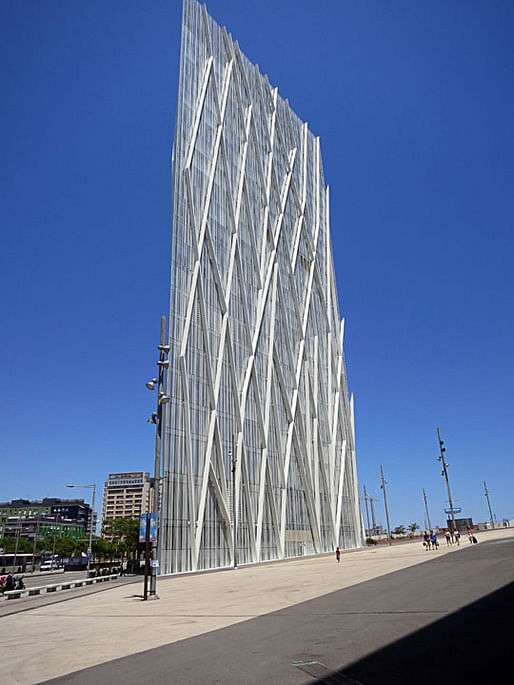
Barcelona Forum by Herzog & de Meuron
The Barcelona Forum was constructed as the center for the 2004 Universal Forum of Culture. It was built to capitalize on the increasing tourism after the success of the 1992 Olympic Games. The event was conceived of by Pasqual Maragall I Mira to support peace, human rights, and environmental sustainability. However the monumentality, location and cost of the building provoked negative responses.


Construction detail of blue surface.
One of the light wells that pierce the large megastructure and allow light into the shaded overhang courtyard.
Montjuïc
View out towards the Plaça d'Espanya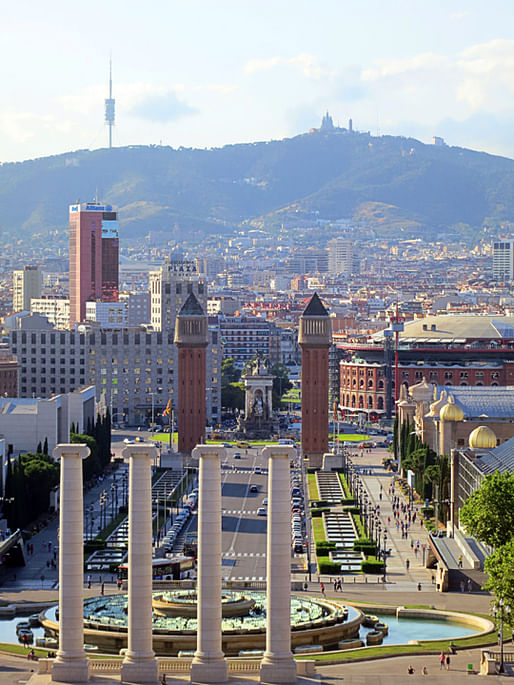
Plaça d'Espanya as seen from the top of Montjuïc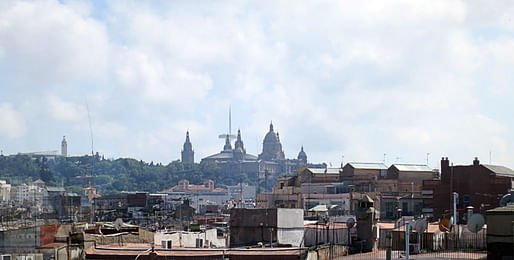
To the west of the medieval Barcelona, in the Sants neighborhood, lays the hilly oasis Montjuïc. Translated from Catalan it means “Jew Hill.” In the 18th century, a fortress was built on the hill as a lookout over the harbor. The hill has been host to various international events. The first event was the 1929 International Exhibition. More recently the 1992 Olympic Games brought about major renovations to Montjuïc. (more on the buildings of Montjuïc in the subsequent Barcelona post)
An escalator that appears to drop you off the face off the earth

Verbena de Sant Joan
On the night of June 23rd is the traditional celebration of the summer solstice known as the Verbena de Sant Joan. In Barcelona, the festival is traditionally held on the beaches of Barcelona with loud parties and even louder petardos (firecrackers, which, incidentally, seem to start for children a week before the festival in the narrow corridors of medieval streets). The following day is a public holiday where everyone recovers from the previous evening.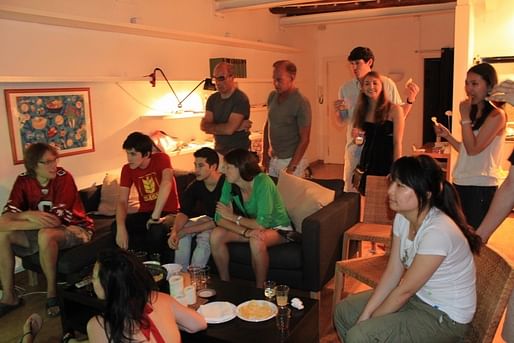
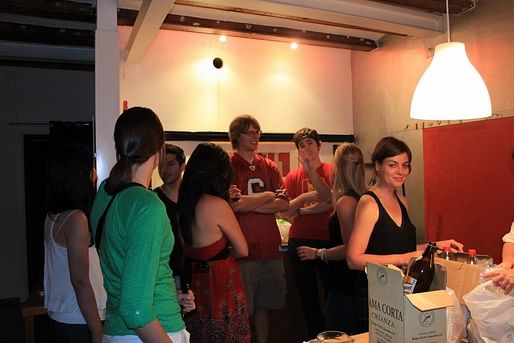
CAVA!
Impressions of Barcelona

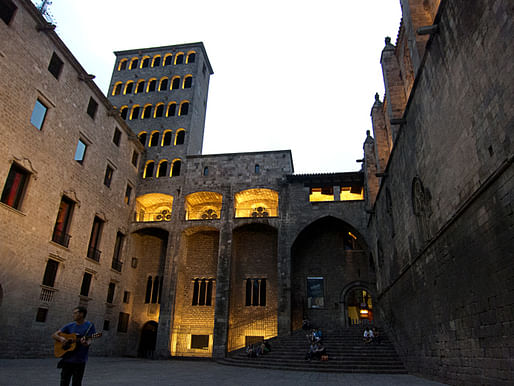

Casa Amatller designed by Josep Puig i Cadafalch.

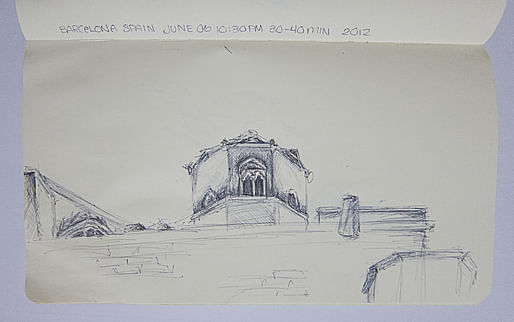
Plaça del Duc de Medinacelli
Sketches of my site in Barcelona. The approach to Plaça del Duc de Medinacelli from carrer Ample.
"Having traveled from the fringes of the city, the center of the city begins to paint color back into the monochromatic pallet of the outskirts. The flat greys and whites of the industrial buildings give way to terracotta red roofs, articulated facades, and vibrant patterns of La Ciutat Vella. Previously the streets were open, quiet and empty of life, now the senses are overwhelmed with a cacophony of a bustling city.
The old city assaults your senses as you squeeze through it. The streets are narrow and brimming with life. Sun stretches to reach between the buildings to highlight the colors of the stones, the colors of the metals, the colors of the bricks. Rivulets of stagnant water lay between the joints of stone pavement, a film of dust resting on its surface. Smells waft not only from the stores but emanate from the damp ground and stained walls. The feeling of the uneven pavement can be felt through the soles of your shoes. Sounds travel from neighboring streets bouncing off narrow surfaces and converge at your ears.
Temptation to join the atmosphere pulls you in as you walk through the narrow passageways. Store with promises of brightly colored goods and wares, vendors standing outside luring you in with promises of a full belly and lighter wallets, old women parked on stools cackling with a cigarette dangling from their bony fingers, young children tossing petardos onto the ground."
- excerpt from A Quixotic City

View from El Gòtic esplanade.
View from across the Passeig de Colom, a large but landscaped vehicular thoroughfare that runs parallel to the coast.

View of the plaza in front of the site.

Conceptual analysis of the existing site conditions.
Conceptual intervention on the building and plaza.

The studio space in Barcelona.
Next up... Barcelona: The Architecture of the Old and New and the culmination of the studio project from concept to building.

This work by Jennifer A Wong is licensed under a Creative Commons Attribution-NonCommercial-NoDerivs 3.0 Unported License.
A new adventure begins as we finish one chapter; we hope to share our story with you. We are graduates of Washington University in St. Louis, Sam Fox School of Design & Visual Arts.
2 Comments
I'm from Barcelona and is a city that blends past, present and future in such a natural and pleasant way that you never get tired of it! I miss it, and every time I visit it I discover something new going on, something that keeps carving Barcelona's identity even more!
It's just wonderful hearing a foreign talking about your city! obviously you forgot to mention a lot of places and architectures but in your post it's easy to recognise how fun was your stage here! I encourage you to come back again, then you will discover a new Barcelona as I do every day I visit it!
Block this user
Are you sure you want to block this user and hide all related comments throughout the site?
Archinect
This is your first comment on Archinect. Your comment will be visible once approved.